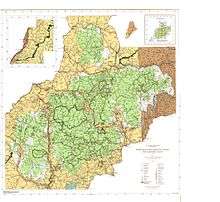White Mountain National Forest
| White Mountain National Forest | |
|---|---|
|
IUCN category VI (protected area with sustainable use of natural resources) | |
|
The Sandwich Range in White Mountain National Forest | |
 | |
| Location | New Hampshire / Maine, United States |
| Nearest city | Berlin, NH |
| Coordinates | 44°06′N 71°24′W / 44.1°N 71.4°WCoordinates: 44°06′N 71°24′W / 44.1°N 71.4°W |
| Area | 750,852 acres (303,859 ha)[1] |
| Established | May 16, 1918[2] |
| Governing body | U.S. Forest Service |
| Website |
www |
The White Mountain National Forest (WMNF) is a federally managed forest contained within the White Mountains in the northeastern United States. It was established in 1918 as a result of the Weeks Act of 1911;[3] federal acquisition of land had already begun in 1914.[4] It has a total area of 750,852 acres (303,859 ha) (1,225 sq mi).[1] Most of the WMNF is in New Hampshire; a small part (about 5.65% of the forest) is in the neighboring state of Maine.[5] While often casually referred to as a park, this is a National Forest, used not only for hiking, camping, and skiing, but for logging and other limited commercial purposes. The WMNF is the only National Forest located in either New Hampshire or Maine. Most of the major peaks over 4,000 feet high for peak-bagging in New Hampshire are located in the National Forest. Over 100 miles (160 km) of the Appalachian Trail traverses the White Mountain National Forest. In descending order of land area the forest lies in parts of Grafton, Coos, and Carroll counties in New Hampshire, and Oxford County in Maine.
The Forest Supervisor's office is located in Campton, and there are three ranger districts: the Pemigewasset District, with offices in Campton; the Androscoggin District, based in Gorham; and the Saco District, based in Conway. Furthermore, there are several visitor centers, including those located at Lincoln, Campton (off Interstate 93), and Lincoln Woods (on the Kancamagus Highway). The National Forest consists of three discontinuous areas. The area to the west of Franconia Notch (a narrow north-south valley primarily within a state park) consists of the regions surrounding Cannon Mountain, Kinsman Mountain, and Mount Moosilauke (though the majority of Moosilauke is privately owned). The main body of the National Forest includes the Presidential Range and many other ranges - most notably, the Franconia, Twin, Bond, Sandwich, Willey, and Carter-Moriah ranges. An exclave of the Forest lies to the north of U.S. Route 2 in Stark and Randolph, New Hampshire.
Six designated Federal Wilderness Areas exist within the Forest: the 27,380-acre (11,080 ha) Presidential Range/Dry River Wilderness, the 5,552-acre (2,247 ha) Great Gulf Wilderness, the 45,000-acre (18,000 ha) Pemigewasset Wilderness, the 35,800-acre (14,500 ha) Sandwich Range Wilderness, the 12,000-acre (4,900 ha) Caribou/Speckled Mountain Wilderness, and the 23,700-acre (9,600 ha) Wild River Wilderness. These areas are protected from logging and commercial industries and are used solely for recreational and scientific purposes. They were formed under the Federal Wilderness Protection Act of 1984, and its amendments. The New England Wilderness Protection Act of 2006 increased the Sandwich Range Wilderness to its present size and created the Wild River Wilderness area.
Because of its beauty, its proximity to major metropolitan areas, its 1,200 miles (1,900 km) of hiking trails, 23 campgrounds, and the presence of a large number of ski areas within or near its boundaries, the WMNF is one of the most visited outdoor recreation sites east of the Mississippi.[6]
Weather
US Forest Service signs on hiking trails at tree line state that the mountain summit areas have "the worst weather in America".[7] The claim is also used by the observatory[8] near the summit of Mount Washington which once recorded a surface wind speed of 231 miles per hour (372 km/h).[9] Since 1849 over 135 people have died on Mount Washington.[10]

See also
- New England/Acadian forests
- John W. Weeks, sponsor of the Weeks Act
References
- 1 2 "Land Areas of the National Forest System" (PDF). U.S. Forest Service. January 2012. Retrieved 20 June 2012.
- ↑ "The National Forests of the United States" (PDF). ForestHistory.org. Retrieved 20 June 2012.
- ↑ "Chronology of National Forests Established Under the Weeks Act". The Forest History Society. Retrieved March 7, 2011.
- ↑ "History of the White Mountain". White Mountain National Forest. Retrieved March 7, 2011.
- ↑ "Table 6 - NFS Acreage by State, Congressional District and County". U.S. Forest Service. 2007-10-07. Retrieved 2008-05-19.
- ↑ "Socio-Economic Assessment, Chapter 1" (PDF). White Mountain National Forest. Retrieved August 19, 2010.
- ↑ Alpine Zone sign
- ↑ PDF observatory
- ↑ 231mph etc
- ↑ Steiner, Christopher (6 April 2009). "Quiet Monster". Forbes. Retrieved 12 February 2015.
External links
- Official website
- Hike the Whites, detailed personal website
- SectionHiker's Backpacking Blog, detailed personal website
- NE Wilderness Act press release
 White Mountain National Forest travel guide from Wikivoyage
White Mountain National Forest travel guide from Wikivoyage Media related to White Mountain National Forest at Wikimedia Commons
Media related to White Mountain National Forest at Wikimedia Commons


